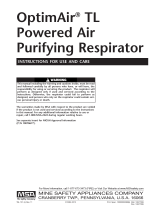
(English)
2
List of Warnings and Cautions within these User Instructions
W WARNING
1. This product helps protect against certain airborne contaminants. Misuse may result in sickness or death. For proper use, see supervisor or
User Instructions, or call 3M in U.S.A., 1-800-243-4630. In Canada, call Technical Service at 1-800-267-4414.
2. Each person using this respirator must read and understand the information in these User Instructions before use. Use of these respirators by
untrained or unqualied persons, or use that is not in accordance with these User Instructions, may adversely affect respirator performance
and result in sickness or death.
3. The U.S. Occupational Safety and Health Administration (OSHA) Standard 29 CFR 1910.134 and the Canadian CSA Standard Z94.4 require a
written respirator program and appropriate training before occupational use of this respirator. Failure to comply with this requirement may
result in sickness or death.
4. These hoods do not provide eye and face protection. When exposed to eye and face hazards, the respirator wearer must wear eye and/or face
protectors appropriate to the hazard. Failure to do so may result in serious injury or death.
5. Do not use with parts or accessories other than those manufactured by 3M as described in these User Instructions or on the NIOSH Approval
Label for this respirator. Failure to do so may adversely affect respirator performance and result in sickness or death.
6. Use of this respirator in atmospheres for which it was not NIOSH certied or designed may result in sickness or death. Do not wear this
respirator to enter areas where:
• Atmospheres are oxygen decient.
• Contaminant concentrations are unknown.
• Contaminant concentrations are Immediately Dangerous to Life or Health (IDLH).
• Contaminant concentrations exceed 1000 times the applicable exposure limit (the assigned protection factor for this respirator system) or
the APF mandated by specic government standards, whichever is lower.
7. Contaminants that are dangerous to your health include those that you may not be able to see or smell. Leave the contaminated area
immediately if any of the following conditions occur. Failure to do so may result in sickness or death.
• Any part of the system becomes damaged.
• Airow into the respirator decreases or stops.
• Breathing becomes difcult.
• You feel dizzy or your vision is impaired.
• You taste or smell contaminants.
• Your face, eyes, nose or mouth become(s) irritated.
• You suspect that the concentration of contaminants may have reached levels at which this respirator may no longer provide adequate
protection.
8. If this respirator fails any of the requirements of the user inspection and performance check, do not use the respirator until all necessary repairs
have been made and the respirator passes the performance check. Failure to do so may adversely affect respirator performance and result
in sickness or death.
9. The BE-10BR hood in butyl rubber offers resistance to certain chemical warfare agents and a range of other chemicals.
10. The BE-10 and BE-10L hoods are made of Tychem® QC Fabric and are liquid repellent. However, the material is not ame resistant and
must not be used around heat, ames or sparks, or in explosive atmospheres. Consult a qualied industrial hygienist and the Permeation
Guide for DuPont Fabrics to ensure that contaminant and/or liquid permeation through the uncoated seams does not occur, and for advice on the
use of Tychem® QC Fabric in your work environment. Failure to do so may lead to serious injury or death.
11. The user must read and follow all User Instructions supplied with the PAPR motor blower or supplied air equipment. Incorrect operation of the
PAPR motor blower or supplied air system could result in reduced airow, interruption of airow to the headpiece or contamination of breathing
air and may result in sickness or death.
12. Your employer must provide compressed breathing air that meets at least the requirements of the specication for Grade D breathing air, as
described in the Compressed Gas Association Commodity Specication G-7.1 in the United States. In Canada, refer to CSA standard Z180.1,
table for quality of compressed breathing air. Failure to do so may result in sickness or death.
13. You must comply with OSHA standard 29 CFR 1910.134, which states that, “Airline couplings shall be incompatible with outlets for other gas
systems to prevent inadvertent servicing of airline respirators with nonrespirable gases or oxygen.” In Canada, refer to the requirements of CSA
standard CSA Z180.1. Failure to do so may result in sickness or death.
14. Always don the respirator in an area where the air is clean. Failure to properly don this respirator before entering a hazardous atmosphere may
result in sickness or death.
15. Always tuck the inner shroud into your work clothes. Failure to do so may reduce respirator effectiveness and may result in sickness or
death.










